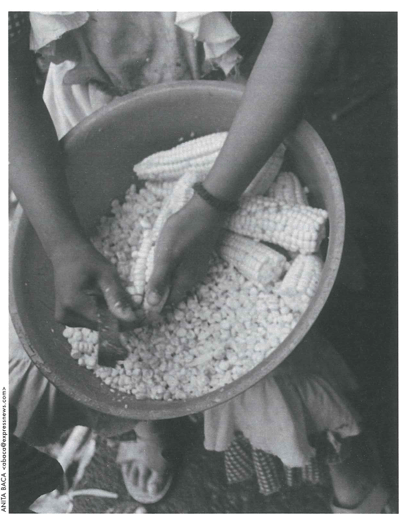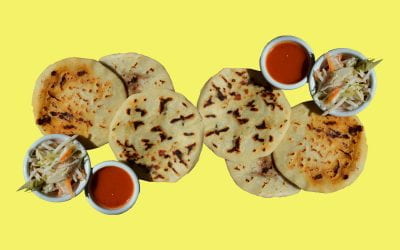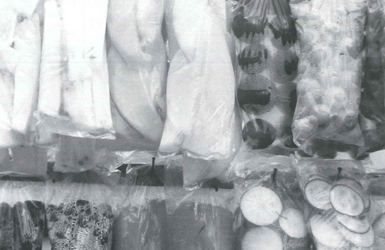Global Food Fights
A Look at the Biotech Revolution

The Biotech Revolution: cutting to the kernel?
The international debate over genetically modified crops pits a cautious, consumer-driven Europe against aggressive U.S. industry. Today’s backlash against the commercial use of recombinant DNA technology for food production isn’t surprising, given the earlier resistance against automobiles from advocates of horse-drawn buggies. While consumer and environmental groups depict genetically-modified (GM) crops as possibly dangerous to human health and the environment, they offer dangers that are as yet only hypothetical, while they overlook the benefits to regions most in need of these new transgenic crop technologies.
The real stakeholders in this debate are the poor farmers and poorly fed consumers in Latin America, Asia, and Africa. It is theyand not the Europeans who are confronted daily with difficult farming conditions and rapidly expanding populations. In the tropics, many consumers are not yet well fed and most farmers are not yet wealthy. Larger investments in the genetic modification of some crops could open a new avenue of escape from poverty and malnutrition for millions of citizens of Latin America and other tropical countries. Yet poor farmers in tropical countries are neither participating in nor profiting from the GM crop revolution.
GM crops are a recent phenomenon; large-scale commercial use by U.S. farmers began in 1996. By 1999, roughly half the U.S. soybean crop and one-third of the corn crop were genetically modified. While seed companies made money, U.S. farmers were the big winners, capturing roughly half of the total economic benefit from the new technology. Because chemical sprays could be reduced, spraying costs dropped substantially, by 10-40 per cent.
Surprisingly, however, the GM seed boom has only been embraced enthusiastically by one Latin American country, Argentina, which has 17 per cent of all land planted with transgenics worldwide. The US and Canada plant 82 per cent of the world total. Mexico has also been growing a small amount of transgenic cropsamong nine countries sharing one per cent of the world’s total production. The weak participation of tropical countries can be partly explained by the industry’s initial focus on temperate-zone crops such as soybeans and corn.
Yet, if properly exploited, the GM crop revolution can have life-changing and even life-saving implications in developing countries. Food-production requirements are increasing rapidly in the tropics due to population growth. Yet agriculture there is lagging because of poor soil; extremes of moisture, heat, and drought; and a plentitude of pests and diseases that attack animals and crops.
Here is where modern transgenic technology carries special promise for the tropics: it can engineer plants and animals with highly specific pest and disease resistance. For instance, transgenic virus-resistant potatoes could help small-scale farmers in Mexico who currently suffer substantial crop damage.
Genetic technology could also improve nutrition by modifying crops to contain more vitamins. The U.N.’s Food and Agriculture Organization has recently estimated that one of every five citizens of the developing world 828 million people in all still suffers from chronic undernourishment. One reason for this is lagging agricultural production in some poor regions where farming is a leading source of income for the poor. Low farm productivity means low income and hence vulnerability to hunger. Transgenic crops are potentially easier for the poor to adopt than conventional crops, since all the potential for enhanced productivity is provided through the seeds themselves. Pests and diseases are managed not with chemicals but through genetic engineering.
Critics of the GM revolution fear that the environment might be hurt if engineered crops are released into rural tropical settings where wild relatives of food plants can often be found. If an engineered herbicide-resistant trait breeds into a weedy wild relative, the result might be a hard-to-manage “super-weed.” Or widespread planting of Bt crops might trigger an evolving population of “superbugs” resistant to the toxin. Legitimate biosafety concerns must be addressed through careful testing and screening on a case-by-case basis. In some countries in Latin America, the means for such testing and monitoring are still largely absent.
Even so, the hypothetical threat to biosafety posed by GM crops remains demonstrably smaller than the actual threat posed by invasions of exotic but non-GM plant and animal species. By some estimates, exotic species movements, unrelated to genetic engineering, currently generate tens of billions of dollars in losses to agriculture in the developing world. If tropical countries are truly concerned with biosafety, GM crops should hardly be their first focus.
GM crops or animal vaccines can actually aid in land conservation and species protection by making farm and grazing lands more productive. Small farmers in the tropics with more productive GM seeds would have less need to plow up or graze more fragile lands in the future. The real threat to biodiversity in poor countries today comes from the cutting of natural habitats such as forests and jungles. Thus, the ultimate environmental payoff from transgenic crop technologies could include fewer watersheds destroyed, fewer hillsides plowed, fewer trees cut, and more species saved.
With the exception of Argentina, Latin America is not participating in the biotech boom. One reason is that multinational GM seed companies have designed their products with profit in mind squarely aimed at rich (mostly temperate-zone) countries. Although some critics have warned that developing countries run the risk of becoming dependent on expensive seeds, the danger is that corporate investments will mostly ignore the tropics because of the lack of purchasing power.
Hypothetically, developing countries should not have to create their own GM seeds from scratch. Some GM crop technologies originally developed for the temperate zone might readily be adapted for use in the tropics by transferring the desirable GM traits into locally grown crops through conventional plant breeding. Private companies, however, have little incentive to invest in such local adaptations where farmers are poor. Worse, they may seek to block local adaptations if poor countries are not willing to protect corporate intellectual property rights (IPRs). Seed companies had once hoped to solve piracy problems by engineering a natural sterility gene into the seeds of GM plants. But such thoughts were set aside in 1999 when Monsanto agreed, under intense pressure from critics, not to commercialize this so-called “terminator” technology.
A World Trade Organization agreement known as TRIPS now requires that all members?including even the poorest countries after 2006 provide IPR protection for plant varieties. Yet many developing countries will try to satisfy this requisite without giving up the traditional privileges of farmers to replicate and replant protected seeds on their farms. This being the case, corporations will remain wary of bringing GM technologies into poor countries.
Public sector leadership such as that provided in the earlier green revolution cannot be counted on. Investments in science are often risky, and the model of market-led development pushed onto borrowing countries by the World Bank and the International Monetary Fund has taken hold. Also, public development institutions shy away from investment in GM technology out of fear: fear of media criticism, of litigation, or of physical attack by anti-GM activists.
More than just GM research is being left undone. Public-sector support for agricultural development has collapsed across the board. Annual foreign aid to agriculture in poor countries fell by 57 percent between 1988 and 1996 (from $9.24 billion down to just $4 billion, measured in constant 1990 dollars), and annual World Bank lending for agricultural and rural development fell by 47 percent between 1986 and 1998 (from $6 billion to just $3.2 billion, measured in constant 1996 dollars). As donors have pulled back, governments in the developing world have not filled the gap.
The highly cautious attitude of European consumers and environmental groups has also set an equally cautious tone in Latin America. For instance, in Brazil, farmers who had hoped to plant herbicide-resistant soybeans in 1999 were blocked at the last minute when a federal judge granted an injunction filed by Greenpeace and a Brazilian consumer institute on grounds of a possible threat to the Brazilian environment. Higher courts are now reviewing the case, but a ban on planting remains in place. Brazilian farmers eager to get GM soybean seeds have been smuggling them in from Argentina. However, the state government of Rio Grande do Sul, partly in hopes of being able to offer GM-free products to consumers in Europe and Japan, has threatened to burn their fields and jail any farmers found to be growing GM soybeans. Greenpeace has thrown its weight behind efforts to keep Rio Grande do Sul and all of Brazil a “GM-free zone.”
It is naturally easier for regulatory authorities in the developing world, under pressure from GM crop critics, to defend a GM crop approval decision if the crop in question has been developed by national scientists with public sector resources, rather than by a foreign multinational corporation. One reason Brazilians are skeptical toward GM soy beans is that the seeds are sold by a US company, Monsanto. There are several other probable advantages from placing heavier emphasis on public sector research. Public sector GM crop development efforts are less likely to neglect the “orphan crops” grown by many poor farmers in the tropics. Private companies do not see poor farmers as good customers, so the profit-making private sector is unlikely to invest in GM varieties of cassava or black beans; it is the public sector (working with nonprofit private foundations) that must invest the needed resources here. Developing GM crops through the public sector is also less likely to leave new innovations heavily encumbered with IPR claims.
The private marketplace, by itself, is not likely to work much GM crop magic for the poorest farmers of the developing world. The lead role that so far has been played by private international companies in the GM crop revolution is arguably a leading reason why this revolution is arguably a leading reason why this revolution has not yet reached the poorest farmers of the developing world, and one reason why GM crops are encountering political and social opposition. During the successful Green Revolution of the 1960s and 1970s, it was not the profit-making private sector that took the lead. Instead, national and international public sector research institutes, philanthropic foundations, agricultural ministries, and extension agencies developed and moved new high-yielding seed varieties to farmers. Too often in the current “gene” revolution the public sector has abdicated this role.
If public sector institutions especially governments in both the developed and developing world are willing to invest more financial resources in shaping this new technology, the benefits can more often be targeted toward poor farmers and might also be placed more often in the public domain. Social resistance to the technology will then diminish as well, as publics come to view GM crops more in the context of a national development policy strategy and less as the product of foreign corporate interests.
Spring/Summer 2001
Robert Paarlberg is Professor of Political Science at Wellesley College and an associate at the Weatherhead Center for International Affairs at Harvard. He is a co-editor, with Otto T. Solbrig and Francesco di Castri, of Globalization and the Rural Environment, published by the David Rockefeller Center for Latin American Studies and distributed by Harvard University Press (2001).
Related Articles
Salvadoran Pupusas
There are different brands of tortilla flour to make the dough. MASECA, which can be found in most large supermarkets in the international section, is one of them but there are others. Follow…
Salpicón Nicaragüense
Nicaraguan salpicón is one of the defining dishes of present-day Nicaraguan cuisine and yet it is unlike anything else that goes by the name of salpicón. Rather, it is an entire menu revolving…
The Lonely Griller
As “a visitor whose days were numbered” in Buenos Aires, Argentina, he tossed aside dietary restrictions to experience the enormous variety of meat dishes, cuts of meat he hadn’t seen…



